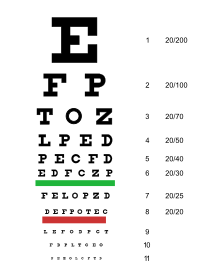Acute visual loss
| Acute visual loss | |
|---|---|
| Other names | Acute vision loss |
 | |
| A Snellen chart, which is frequently used for visual acuity testing | |
Acute visual loss is a rapid
Main causes
Retinal detachment
Retinal detachment should be considered if there were preceding flashes or floaters, or if there is a new
Glaucoma
Angle-closure glaucoma should be considered if there is painful loss of vision with a red eye, nausea or vomiting.[4] The eye pressure will be very high typically greater than 40 mmHg.[5] Emergent laser treatment to the iris may prevent blindness.[4]
Macular degeneration
Wet macular degeneration should be considered in older people with new distortion of their vision with bleeding in the
Giant cell arteritis
Giant cell arteritis should be considered in an older person with
Vascular occlusions
- Central retinal artery occlusion: CRAO is characterized by painless, acute vision loss in one eye.[11]
- Central retinal vein occlusion: CRVO causes sudden, painless vision loss that can be mild to severe. [12]
- Branch retinal vein occlusion: sudden painless vision loss or visual field defect are the main symptom of BRVO. [13]
- Branch retinal artery occlusion: BRAO may also cause acute painless loss of vision. [14]
Vitreous hemorrhage
It is one of the most common causes of acute or subacute decrease in vision. [15]
Hyphema
Blood in the anterior chamber of the eye is known as hyphema. Severe hyphema covering pupillary area can cause sudden decrease in vision.
References
- ^ "Acute Visual Loss - MEDSKL". medskl.com. Retrieved 23 January 2019. (Video's script with inline references)
- ^ PMID 21406128.
- ^ "Facts About Retinal Detachment". National Eye Institute. October 2009. Archived from the original on 28 July 2016. Retrieved 26 July 2016.
- ^ a b "Facts About Glaucoma". National Eye Institute. Archived from the original on 28 March 2016. Retrieved 29 March 2016.
- ISBN 9781908541727.
- ^ a b "Facts About Age-Related Macular Degeneration". National Eye Institute. June 2015. Archived from the original on 22 December 2015. Retrieved 21 December 2015.
- ISBN 978-0323085144.
- ^ "Giant Cell Arteritis". National Institute of Arthritis and Musculoskeletal and Skin Diseases. 13 April 2017. Archived from the original on 22 October 2017. Retrieved 21 October 2017.
- ^ "Giant Cell Arteritis". National Institute of Arthritis and Musculoskeletal and Skin Diseases. 13 April 2017. Retrieved 19 October 2018.
- PMID 24988557.
- PMID 23470793.
- ^ "Eye Strokes: CRAO, BRVO And Other Retinal Artery And Vein Occlusions".
- ^ Musa Abdelaziz, MD, Mahdi Rostamizadeh, Baseer Ahmad, MD. "Branch retinal vein occlusion".
{{cite web}}: CS1 maint: multiple names: authors list (link) - ^ Matthew Santos, Robert H. Janigian, Jr. M.D. "Branch retinal artery occlusion".
{{cite web}}: CS1 maint: multiple names: authors list (link) - ^ John P. Berdahl, MD, and Prithvi Mruthyunjaya, MD (March 2007). "Vitreous Hemorrhage: Diagnosis and Treatment".
{{cite web}}: CS1 maint: multiple names: authors list (link)
